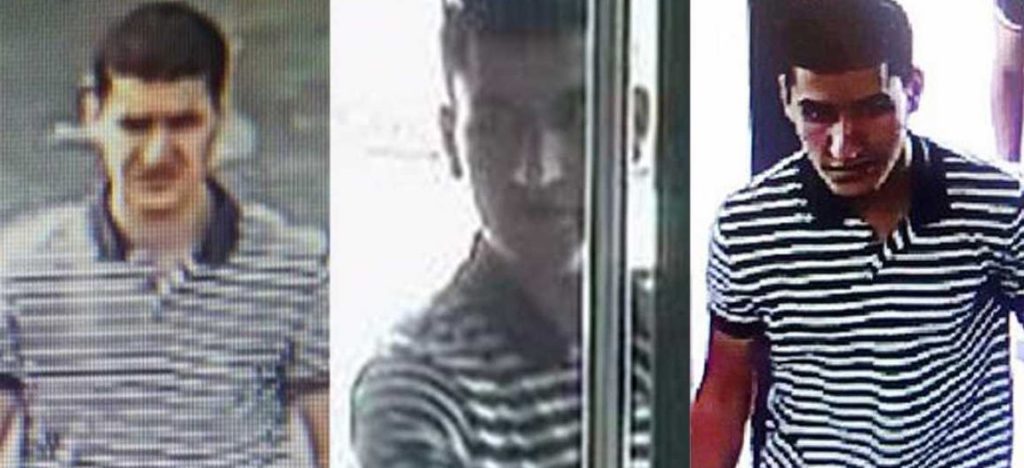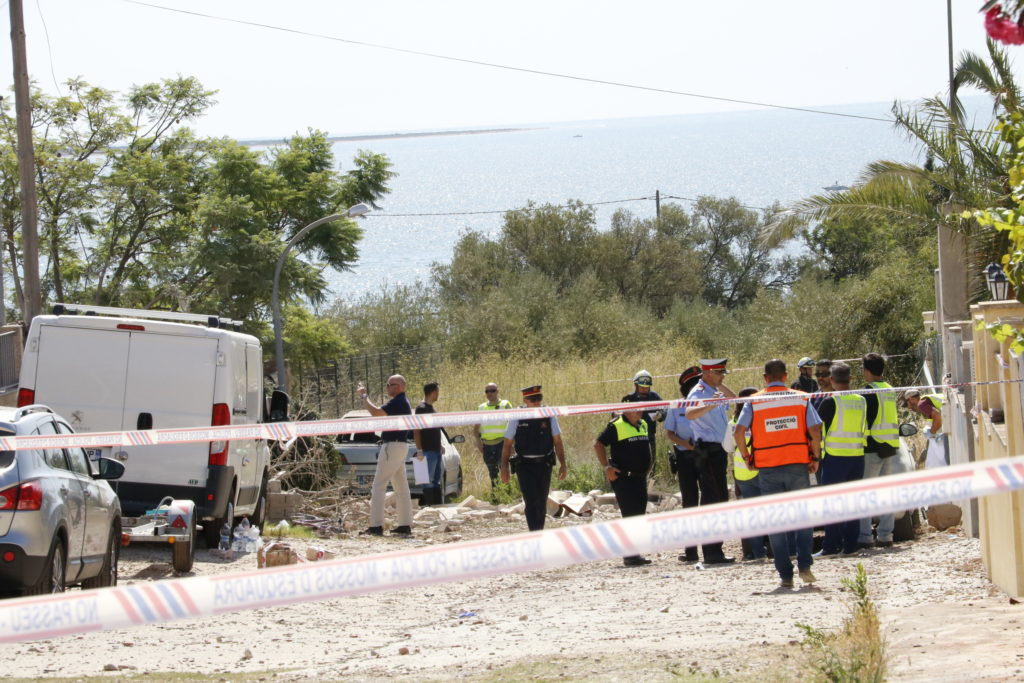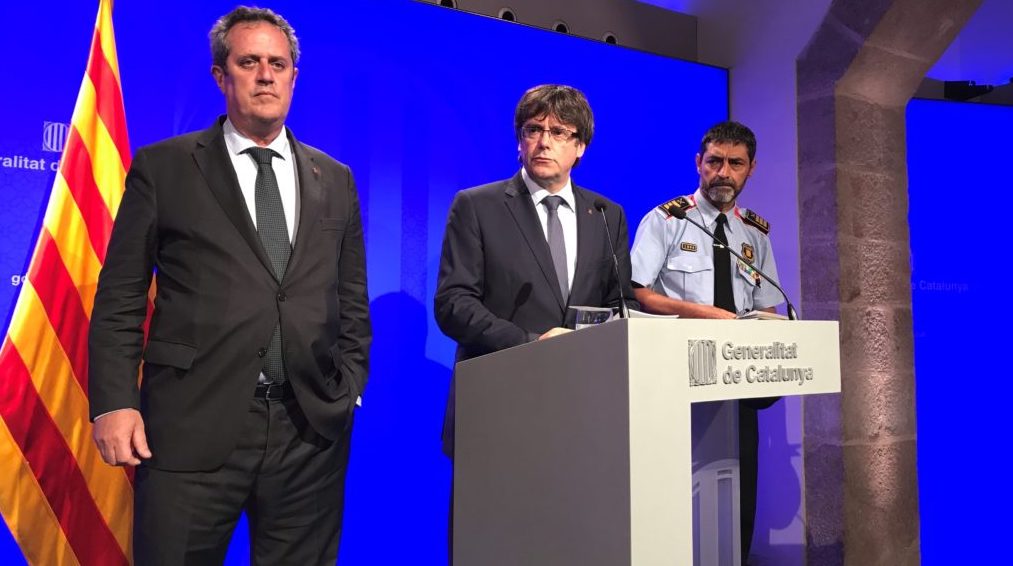16.08.2018 - 20:02
|
Actualització: 16.08.2018 - 22:02
On August 17 last year Catalonia was shaken when terrorists attacked Barcelona and Cambrils in what would become an unprecedented test for the Catalan government and, in particular, for the Catalan police force. This is the story of how the Mossos d’Esquadra team who have been closely monitoring the jihadist threat for years experienced those days.
A shop is transformed
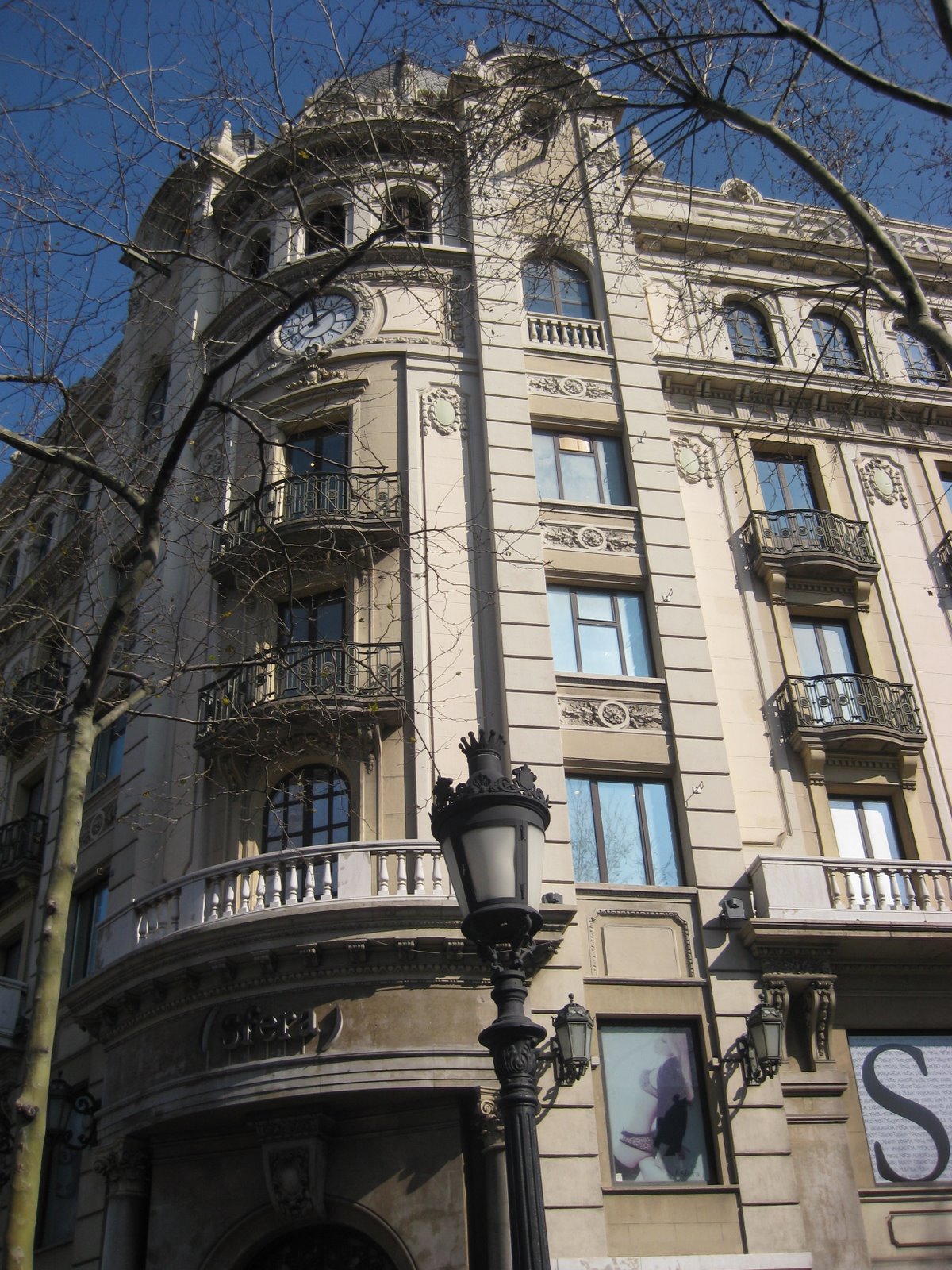
The sign outside was unusual, but nobody paid it much notice. On August 17, only one hour after the Barcelona city attack, the premises at 23 Plaça de Catalunya was turned into a forward post for the emergency services that had to handle an attack for which nobody was fully prepared, even if they had been expecting it.
At the time the building on the corner of Plaça de Catalunya with La Rambla was a Sfera shop, part of a chain of department stores owned by El Corte Inglés. But shortly after the attack all the clothes and other items on display were removed at lightning speed. The ground floor had to be used as an improvised field hospital and the upper floors would become a working space, mainly for the police, who were trying to make sense of what had happened and how. As the sun set on August 17, the advertising posters and the sign showing what clothes you would find on each floor were all that was left of the store which had been one of many on Barcelona’s best known street until that very morning. The action by a young man from Ripoll named Younes Abouyaaqoub had changed everything. Even the purpose of that retail premises.
The building’s surface totalled nearly 8,000 square metres and every inch was taken up by hosts of people who were either busy trying to save lives or sorting clues to respond to the attack. Above all, they were trying to figure out how to get the man whose identity still remained unknown but whose actions everyone already knew about. Thirteen people had been killed —eventually a total of fifteen lives would be lost— by a vehicle that drove down La Rambla mowing down everyone on its path until it ground to a halt at the Joan Miró mural that lies by the Liceu opera house. The van travelled 550 metres starting at 16.50 when it was mostly tourists walking on Barcelona’s La Rambla.
Inside the forward investigative post set up by the Catalan police in the Sfera building questions began to pile up frantically from the word go. Was the attack carried out by a lone wolf, a one-man job? Was the white van the only vehicle involved or was it being followed by accomplices, perhaps driving other vehicles? Who was the van driver? And, above all, where was he now? And more: were there other attacks in the offing, perhaps imminently?
The so-called Operation Cage had sealed off Barcelona city and the intelligence division of the Mossos had activated Operation Cronos for the first time ever, which meant that every available operative was assigned to investigating the incident. They were spearheaded by the team that had been fighting the jihadist terror threat for years, who were likely the most worried of all.
Abouyaaqoub had carefully inspected La Rambla ahead of the attack
The first shock came early on for the investigators when they learnt the odd route which the attacker had followed.
Immediately after the attack, all retail premises on La Rambla were shut down with members of the public confined inside. The safety of all those people was a top priority, but so was detaining the perpetrator, if he hadn’t managed to get away and was hiding in one of the shops. That is why the Mossos combed through every business meticulously and escorted everyone to Plaça de Catalunya.
Right there, smack in the middle of the square, people were identified one by one and police asked them to share any pictures they might have taken: photos, video footage, anything. Anyone who was in possession of any such content was walked by a police officer to the top floor of the Sfera building where the pictures were downloaded, sorted and tagged with all the relevant details: who had taken them, where, what time … From then on, watching hours and hours of footage was key to understanding what they were facing: watching, sorting and forming a picture of the moments leading up to the attack.
Modern cities are full of cameras and, in particular, every business on La Rambla is fitted with CCTV. Their footage, plus the pictures taken by passers-by before, during and even after the attack were key to understanding what had happened. By matching, comparing and cross-referencing them, the Mossos managed to reconstruct the events that would change Catalonia and her capital city for ever.
And, unlike what was initially thought, Younes Abouyaaqoub hadn’t entered La Rambla at the top and then driven down the boulevard killing people left, right and centre. Not at all. Prior to the attack, the perpetrator had driven up La Rambla in the opposite direction, idling up the road in his van all the way from the port. Minutes before the attack, he had studied his target, reconnoitring the scene and possibly anticipating the problems that he might encounter.
While the van —a Fiat Talento— was travelling up La Rambla, the leisurely passers-by could not know what was about to unfold and had no obvious reason to be afraid of anything. Having driven across Plaça de Catalunya, Abouyaaqoub turned left into carrer Pelai and this time the van suddenly sped up and climbed onto the centre of the boulevard. Once there, the driver kept swerving right and left in order to mow down as many people as possible. The calm of that August afternoon was immediately shattered by the alarmed shouts of people running away from the scene and the cries of pain from the injured, who could not make sense of what was going on. Eventually the van ground to a halt. Then Abouyaaqoub got out and ran away heading for La Boqueria market amid the surrounding confusion. Right then the most important pursuit in the history of the Catalan police force kicked off. It spanned nearly one hundred hours, four days which seemed to last forever, especially for the Mossos tasked with anti-jihadist operations.
A lone wolf?
Carefully watching CCTV footage from La Rambla had uncovered two important clues. Firstly, that only was person had been in the van and he seemed oddly calm. Experts knew for certain that before an attack jihadists tend to take stimulants. But in this case the opposite seemed true. The driver looked as if he had taken a tranquilliser. The other important clue is that there was just the one van. Thanks to the video footage, policer officers tracked and followed the route of every vehicle which had driven in front of or behind the van at some point, and none of them were linked to the incident. Likewise, the driver did not seem to have any lookouts on foot, standing by along the route. Nobody was waiting for him to get away together. Therefore, he was by himself, or at least it seemed that way.
But the anti-jihadist Mossos team weren’t so sure. All of them are highly experienced officers and are well-acquainted with anything to do with Islam in Catalonia and have combed through the whole nation collecting information that proved to be priceless on the day of the attack. They were persuaded that nobody ever acts by himself and were speculating about the possibility that there could be at least one other individual involved. For this reason, their first job was to phone up every source asking them for any detail, no matter how small, any clue, any lead they could chase up. Surely someone had to know something about what had just gone down?
Several invoices issued in Cambrils turned up in the van, plus some scattered details about the driver’s identity. This material was processed while they scoured for prints and any traces of DNA. Still, it was all patchy and amounted to very little. Meanwhile, time was ticking away. Suddenly one of the phone calls provided a lead. Someone claimed to have spoken to the alleged perpetrator only a few days earlier.
The evidence points south
The Mossos team drove south at full speed, to the southern Catalan town which their source had indicated. They were in an unmarked vehicle but had a police siren on, which made them a conspicuous target. Their heads were buzzing with worry. What if the tip-off was just bait ahead of a second attack. Could someone be luring them to a kill spot?
Escorted by another police car, they got on the motorway —dotted with check points— where traffic had ground to a halt. Operation Cage had been brought to level 3, which meant that all of Catalonia was being combed. A grid with over 600 checkpoints had been laid across the nation, which inevitably meant that the ensuing traffic chaos would be unprecedented. A lane was opened up in the opposite direction to allow them to travel south and avoid the queues, which they did as fast as possible. They met their source at the Tarragona police station, where their cars and an Arab-looking man rattled the nerves of their colleagues there until an explanation was offered. Finally, that clue turned out to be a dead-end. There were no cameras in the area where the informer claimed the perpetrator had travelled days before the attack. But, just by chance, they now happened to be not far from a second unexpected scene, where another attack was about to unfold.
A second attack in Cambrils
They meant to return to Barcelona, but first the group stopped off at a café and ordered some sandwiches in a rush. By now they were pretty sure that the attackers were local because the ramming tactic —this time with a van— was the most rudimentary of all and the one that required the least support and expertise.
But suddenly everything took a fresh turn. A phone call alerted them to a second incident that was unfolding in Cambrils. Information was inconclusive, but it appeared that a group was holding hostages on the main promenade.
It was a coincidence that the tip-off they were chasing up had placed them a short distance from the second incident. So they hopped into their cars and drove there without delay. A second attack would certainly complicate matters a great deal and give a whole new dimension to what had happened in Barcelona.
The first report was inaccurate. There was no hostage situation in Cambrils, but the scene they found when they got there was just as complex. A group of five young men had driven to Cambrils, having purchased knives and axes from a roadside shop along the way. They intended to go to Cambrils and do the same as in La Rambla. They would drive their car to the promenade and run over as many pedestrians as possible. Eventually they would get out of the vehicle to continue their killing spree with the weapons they had procured until they themselves were taken out. That is why they were wearing fake explosive vests. They knew police would shoot to kill if they wore them and the officers suspected that they might be setting them off.
Their plan was foiled by one of the one hundred spot checks set up by the Mossos d’Esquadra, which was located at the top of the promenade, by a roundabout. Everything suggests that the men in the car (17 year-old Moussa Oukabir, 19 year-old Said Aallaa, brothers Omar and Mohamed Hychami, aged 21 and 24, plus 22 year-old Al-Houssaine Abouyaaqoub) did not notice the checkpoint until they were already in the roundabout and could not manoeuvre to avoid it. They had driven into Cambrils along Rambla de Jaume I and the checkpoint was out of sight, to their left. When they noticed it, they chose to speed up and try to get past it, but their car overturned and crashed into some cargo containers that were sitting on the stretch of road that separated the beach from the port.
All five occupants got out of the vehicle, an Audi A3, and began to attack everyone they met. One of the Catalan police officers manning the checkpoint shot them with his long gun, killing four of the attackers. The fifth man ran away along the promenade, with police officers in pursuit. He appeared to be wearing a suicide vest.
As in Barcelona, police ordered everyone to lock themselves safely inside the local shops. The runaway, the sole survivor of the terrorist group, travelled a distance of 50 metres from the main promenade to the middle of the road. He stopped ten metres from Taberna Kupela [a local restaurant], pretending to attempt to detonate the suicide vest he was wearing. That could have killed everyone who was inside the restaurant at the time, so the police decided to use their guns. First they shot him in the legs, as they shouted for him to surrender. The young man fell to the ground, but got up again. A second volley of gunshots killed him. The members of the investigative team got there in time to watch the end unfold and checked that the vest was fake: its job was to ensure that the wearer would not survive the attack. While this was underway, medics were trying to save the life of a 67 year-old Spanish woman who had been injured by one of the attackers. Eventually she died in a Tarragona hospital a few hours later.
Pau Pérez’s murder
During the time between the La Rambla and the Cambrils incidents, Barcelona city saw a most unexpected turn of events: Pau Pérez, a young man from Vilafranca del Penedès, was stabbed to death by Younes Abouyaaqoub, who wanted to steal his car. It happened in the city’s university district, where Abouyaaqoub had ended up after following an erratic route on foot via carrer Nicaragua and past the FC Barcelona stadium. This was later reconstructed in a rather detailed manner. Once in the university area, Abouyaaqoub stumbled into Operation Cage. There was no way he could leave the city without being identified. His reaction, shortly after 6 pm, was to murder Pau Pérez as the victim was going to retrieve his car from a nearby car park. He lifted Pérez’s body into the vehicle and drove to the city’s edge, hoping to get through one of the checkpoints laid on Diagonal.
With the young man’s dead body lying on the back of his Ford Focus, Abouyaaqoub chose to ram into the checkpoint head-on. This sort of police spot checks are divided into three sections. The first one is a sorting area where an officer decides which vehicles should be stopped; the second is an inspection area where vehicles line up waiting to be searched; the last area is used to stop or chase after any vehicle that attempts to jump the checkpoint. Abouyaaqoub rammed into a female police sergeant, who was injured, and he went through all three sections of the checkpoint, which led to a shooting chase. The pursuit came to an end a few miles down the road, in Sant Just Desvern, opposite the Walden building. When police officers finally approached the vehicle, they found Pérez’s dead body, which initially led them to believe that he was the driver that had rammed into the checkpoint and had been wounded during the chase. Needless to say, they were shocked to find a knife stuck into the body, which was not on the driver’s seat. The actual driver had managed to get away on foot.
Police immediately made the connection between Pau Pérez’s murder and the terrorist attack, but were coy about it when talking to the public. Once it was confirmed that Abouyaaqoub had been driving the Ford Focus, the search for the fugitive jumped to a new level: from then on, police knew that he was alone, carless and, more importantly, that he had left Barcelona city, which was a serious mistake as it would have been easier to vanish in a big city. At 13.12 on August 21 the Catalan police eventually released four photographs of Abouyaaqoub and they revealed that he was the man who had murdered Pau Pérez. Only a few hours later, a woman spotted him in a Mercadona car park in Subirats.
The Alcanar house: drugs or bombs?
The hours immediately after the attack were filled with contradictory reports and confusion, which is par for the course in an incident of this nature. The furious pace of events was in contrast with the necessarily sluggish speed of any investigation. Every rumour, every detail had to be double-checked as police intelligence officers tried to join the dots and find the link that would paint an accurate picture of the scope of the operation.
The explosion in a house in Alcanar, where later we would learn that the attacks had been prepared, was particularly confusing. On the evening of August 16, the day before the attacks, a massive explosion shook Alcanar beach. Initial reports by the fire and police departments mentioned one dead and seven injured, and they emphasised the large number of gas canisters found at the site, as well as the fact that “foreigners” had moved into the house after letting themselves in, according to reports by local residents.
Removing all the rubble proved troublesome because of a huge secondary explosion that injured a police officer. The building was covered in debris again and all efforts were halted until they had checked that the workmen and the crane operator were in no danger. Much to the Mossos’ surprise, a Guardia Civil team turned up wanting to take over the inquiry, which was extremely unusual. The Catalan police wouldn’t allow it. Later it transpired that one of the dead was a Spanish police informer, which stirred a lot of talk.
The first officers to arrive at the scene found several chemical products. The jihadists had used them to manufacture an explosive known as TATP, but they were also compatible with the production of several kinds of drugs. That is why they linked the Alcanar blast to an earlier explosion on May 14, only five months before, in a Segur de Calafell villa where a group of people were handling chemicals for drug-making. Like in Alcanar, they were living in a house they occupied illegally in a quiet residential area and they had used a significant number of gas canisters. And it was only 140 km from Alcanar. At first —and before the Barcelona and Cambrils attacks— it made sense to assume that the two incidents were connected.
It wasn’t until the house’s perimeter was stabilised and they began to find objects that linked the residents to a possible jihadist cell that the Alcanar blast was tied to the attacks in Barcelona and Cambrils. Until then, the drug cooking lab hypothesis was given priority. However, the Catalan police began to identify the cars parked nearby as a matter of course and phone their owners. That is when a name was flagged for the first time: Younes Abouyaaqoub, and a village, which would be forever associated with the attacks: Ripoll.
Ripoll’s imam is a Spanish police informer
About 300 of Ripoll’s 10,000 resident population are Muslims. At the time of the attacks there were two mosques in the Ripollès capital: al-Fath (‘the door’) i Annour (‘the light’). The latter was a new, splinter mosque which was very small and not terribly well-off. At one point, personal and community management issues prompted a large majority of the Muslim community to switch to the newer prayer centre. Annour grew, but never attracted a large flock. At best, seventy people attended Friday prayer there.
Back then there were 286 registered Islamic prayer centres in Catalonia. Praying is no crime and no particular faith can predispose anyone to anything. Therefore, based on the Catalan police protocols, just over 100 centres had been flagged in any way. None in Ripoll. But once the Alcanar cars had been identified —and especially after the Cambrils attack—, Ripoll’s connection with the jihadist cell became glaringly obvious. Four of the attackers were Ripoll residents, which meant that there was a well-structured group in the Catalan village.
The reaction was immediate and the members of the investigative team rushed to Ripoll to interview the leaders of the two mosques, which was not easy given the avalanche of reporters that had taken the village by storm. The president of al-Fath claimed no knowledge. In contrast, Annour’s left them speechless.
Ali Yassine stated that the Spanish police had visited the mosque on three occasions, the last time only a month earlier. The Catalan police had been kept completely in the dark. At that point nobody knew yet that Abdelbaki es-Satty, the man who had been the Annour imam until just a few weeks earlier, was a Spanish police informer and the leader of the cell that had prepared the attacks. The fact that he had perished in the Alcanar blast was also still unknown.
The Spanish police knew the imam was on the run
The president of the Annour mosque provided an account that was as matter of fact as it was puzzling. He recounted how in April 2016 two Girona-based Spanish police officers had turned up enquiring about the individuals who served on the prayer centre’s management board. They left an official email address to which they sent all the information requested by the officers. Later that year, after the summer, two other Spanish policemen visited Ripoll, asked to see the board’s rules and regulations and specifically enquired about Abdelbaki es-Satty. This time a spoken reply was given. Finally, in July 2017, Spanish police paid the mosque a third visit and asked if there had been any changes to the centre’s management structure. The answer was that Abdelbaki es-Satty had been dismissed and he had left saying that he was travelling to Morocco. The Spanish policemen didn’t comment.
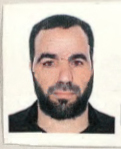
Eventually the Spanish authorities admitted that es-Satty had been a Spanish police informer for years, so several uncomfortable yet obvious questions came up: why would the Spanish police conceal from their Catalan colleagues the fact that they had visited Ripoll? How come they didn’t know that their informer had run away and later they never bothered to find out his whereabouts? It is a fact that a month before the attacks they knew that one of their informers had vanished, an ex-convict with proven jihadist connections who had aided in earlier operations. At the time it was still unclear whether any of the human remains that kept turning up in the Alcanar house belonged to es-Satty. But this was confirmed soon afterwards. Then the rumours and the questions about what information the Spanish government was privy to escalated. Yet no fully satisfactory explanation has ever been provided.
Now that this information had become available, the full picture of what had happened was beginning to emerge. The young men killed in Cambrils were a group from Ripoll. Es-Satty, a man with a jihadist record that had been concealed from the Catalan police, appeared to be the connection that brought them together, as well as the leader of a jihadist terror cell that only then we were beginning to put names to. Every friend and acquaintance of the Cambrils attackers was looked up and Younes Abouyaaqoub began to look like the main suspect for the van driver. However, there were still many doubts. An eyewitness, a young man who had seen the van arrive up close from a bus stop at the top of La Rambla, couldn’t identify Abouyaaqoub when the Mossos showed him several photos on Saturday evening. The investigation was making progress and narrowing down its objective, but there wasn’t enough evidence yet to state who was responsible for the Barcelona attack. They finally did so on Monday, three days after the operation had begun.
The accusation
By Monday August 21 at 13.12 the Catalan police had gathered enough evidence to name Younes Abouyaaqoub as the missing van driver. Time and again, every piece of information collected on the attack kept pointing in his direction. Everything suggested that, after the accidental explosion that destroyed the Alcanar house, Abouyaaqoub drove away in one of the vans in which they were planning to carry the explosives that they had manufactured. There were no reliable clues as to what he did in the following hours, but nearly one day later he drove into Barcelona and carried out the attack on La Rambla. It was Thursday. The fact that he drove up the boulevard first and waited a full day after the explosion indicated a cool head, but we also knew that he was somewhat afraid and was not in full control of the situation. Hours later he murdered Pau Pérez to steal his car and dodge Operation Cage. He got out of the city and we lost track of him until he was spotted in Subirats. We do not know what he intended to do and where he meant to go, not even if he ever learnt what his friends had done in Cambrils. But, quite clearly, he didn’t want a martyr’s death, as he must have several chances of that between Thursday and Monday. The massive hunting operation launched by the Catalan police drove him into a corner, on the road that joined Sant Sadurní d’Anoia and Subirats.
Showdown in Subirats
Once again, on Monday police information officers were near Subirats. Specifically, they were following a fresh lead and talking to an informer in Vilanova i la Geltrú. Right then they were ordered to rush to Subirats, where a woman claimed she had spotted Abouyaaqoub. The journey by car was barely half an hour long but it was a frenzied thirty minutes because they kept getting increasingly precise updates on the police radio about Younes Abouyaaqoub’s presence in the area. From their car they could follow the police helicopter flying overhead, which signalled to them the perimeter of the search. They located Abouyaaqoub right away and they were some of the first officers to get to the spot were he died. A Rural Proximity team of the Mossos —one of many deployed across Catalonia— had stumbled into him and shot him dead.
The police team was looking into one of the many reports that kept coming in through every possible channel. Every one of them was chased up, even though many led to a dead-end. That was not the first report received by that particular team, but it would be the definitive one. The most wanted fugitive was found on a country road in a small wooded area. He was right in the middle of the road when the Mossos spotted him after a bend. Younes Abouyaaqoub did not react until the two officers got out of their car and approached him on foot. Then he opened his shirt clearly showing a suicide vest and started walking towards them with a challenging demeanour and shouting “Allah is great!” ever more loudly. The police officers immediately emptied their magazines and even loaded a third one into their weapons. Abouyaaqoub collapsed on his face.
The intelligence unit officers got to the scene a few minutes later, by the time another local team had already arrived. Before the body could be identified, though, a bomb disposal team had to check whether the explosive vest was fake, which meant Abouyaaqoub had to be turned on his back. In a matter of minutes, a swarm of reporters descended on the area, which the police’s mobile brigade rushed to cordon off. It was only a few minutes after 4 pm, but the Mossos did not confirm the identity of the dead man or call off the hunting operation till 9 in the evening, once everything had been double-checked and there was no possible error.
As a matter of fact, it was one of the intelligence officers who first approached the body to see if he was indeed the man they thought they were after. Abouyaaqoub was very dirty after four days on the run with no obvious destination. He didn’t have a phone or any money on him, but kept a knife on his waist. The confirmation of the body’s identity was communicated with a phone call so as to avoid sending a radio message that might have been leaked. The next day some newspapers printed a photograph that showed several police in uniform and, in the background, a barely discernible group of officers in plain clothes who seemed to be having a discussion. They were the members of the jihadist intelligence unit who were still trying to come to terms with what had happened. More than anybody else, they were aware of the gravity of the events and what might have happened if the terrorists’ original plan had been a success. The team travelled straight from Subirats to the Catalan Police’s main HQ in Sabadell. A lot was still unexplained, many questions had to be asked and, above all, they had to confirm that the Ripoll cell had been taken out with Abouyaaqoub’d death.
The last one hundred hours had been the toughest ever for them, as well as the most furiously-paced. Some had barely had a chance to sleep or they had only got some shut-eye on a couch or at a friend’s in order to stay close to the office. All of them had had to sift through an endless maze of clues to grasp what was going on and what they were supposed to do. During those four days they were given a free hand to work with their informers, follow leads and analyse anything they deemed necessary. Indeed, it was true that they had helped to take out the terrorist cell in an unusually short time for this sort of attack in Europe. Still, they struggled to accept that the attack, the one that they all knew would come one day or another, had finally happened and had placed Barcelona on the same map as London, Manchester, Stockholm, Paris, Berlin, Munich, Nice, Brussels, Madrid…
Major Trapero’s orders
The officers of the Mossos d’Esquadra Intelligence Unit are very rarely found all gathered in one spot. Besides those based in the Egara HQ, there are teams scattered all over Catalonia, organised to respond to internal and external threats. They include analysts, IT experts and field officers who walk the streets all day talking to contacts, anticipating potential issues and trying to foil any attacks.
Months before the Barcelona and Cambrils incidents, the auditorium in the Sabadell HQ saw an unusual, unprecedented gathering. Every officer in the Intelligence Unit was present to witness the unveiling of Cronos, the plan which the Catalan police had devised to respond to a terrorist attack, if there was ever one. Several high-ranking officers went through it in detail, but it was Major Josep Lluís Trapero’s address that stood out. By then level 4 on the terror alert scale had been declared and Trapero told his officers that this meant an attack could come any time and it was unrealistic to assume that every attempt could be thwarted. So he make a very explicit, specific request: if there was ever such an attack, their reaction had to be the best and swiftest to minimise the consequences for the Catalan people. That is precisely what the officers under his command achieved during that long one-hundred hour period in August.
On October 28 2017, two months after the terrorist attacks, the Spanish government sacked Major Trapero. This was one of the first decisions they took following the Madrid-staged coup under the guise of direct rule, triggered by invoking article 155 of the Spanish constitution. A few days later we learnt that a Spanish court was going to charge Trapero with sedition. Catalan minister Quim Forn, the operation’s political leader, was detained and put in prison. He is still there today. Furthermore, with the Catalan police now under direct orders of Spain’s Ministry of the Interior, the anti-jihadist terror unit was sidelined and left without the funds and tools they needed to do their job. Eventually this situation was reverted when a new government was formed in Catalonia, nearly one year after the terrorist attacks.
